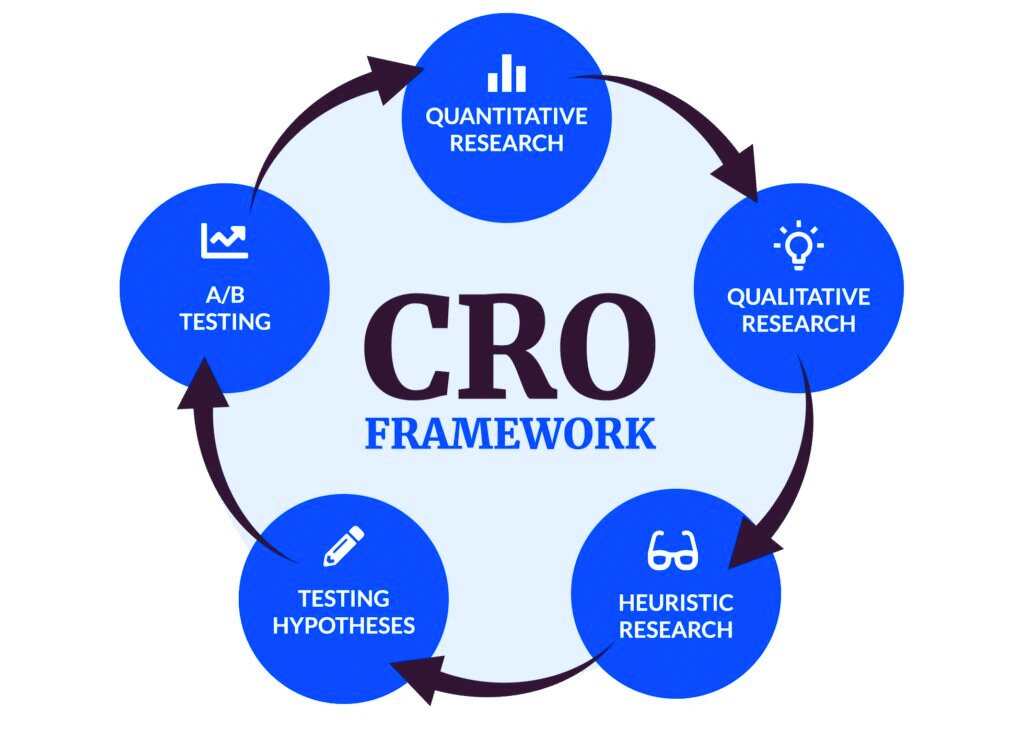What Is Conversion Rate Optimization?
Conversion rate optimization is the process of enhancing the effectiveness and efficiency of a website, landing page, or marketing campaign to increase the percentage of visitors who takes desired action such as purchase, booking an appointment, subscribe, or filling out a form. Based on the company’s desired goal. It involves systematically analyzing and improving various elements of a website or marketing campaign, including design, user experience, content, and call-to-action.
According to Antraajaal by implementing conversion rate optimization techniques businesses can aim to maximize their marketing efforts. Rather than only focusing on increasing traffic to a website or landing page. This approach leads to significant improvements in conversion rates, customer acquisition, and ultimately, revenue and profitability.
Elements Of Conversion Rate Optimization
To get the desired action from the visitors here are some key elements:
- User Experience (UX): Creating a positive and seamless user experience is crucial for conversion optimization. This includes easy navigation, clear and compelling messaging, visually appealing design, fast page load time, and mobile friendliness.
- Call-to-Action (CTA): It impacts by various factors like design, placement, and wording of your call-to-action button or link. Make sure your button or links are effective, visible, clearly communicate, make sense, add value, and create an urgency to take the desired action.
- Landing Page Optimization: Optimizing landing pages involves ensuring that they align with the visitors’ users’ expectations and effectively communicate or convey the message to the visitors. It includes elements like headlines, subheadings, Images, benefits, social proof, and transparency for trust building so that visitors engage with the website or take the desired action.
- Forms and Checkout Process: Breaching information is something that terrifies visitors. Make sure you reassure users about security and privacy to enhance conversions. Optimize the forms and checkout process for minimizing friction and reducing abandonment rates.
- Content Optimization: Providing high-quality and relevant content that aligns with visitors’ expectations can significantly impact conversions. Optimize your content, catch headings, persuasive product descriptions, and relevant images and videos. To convey your message and add value to the call to action.
- A/B Testing: A/B testing involves two or more variations of a web page or element to determine which one performs better in terms of conversions. It is more like different plans of your content for websites or campaigns.
- Data Analysis: using web analytics tools and data analysis helps you gain insights into user behavior, and make data-driven decisions. Analyzing metrics like bounce rate, time on page, and click-through rate can highlight areas of improvement.
- Customer Feedback: Actively seeking and incorporating customer feedback through surveys, user testing or customer support interactions can provide valuable insights into areas that need improvements. Addressing user concerns and queries can positively impact conversions.
Benefits Of Conversion Rate Optimization
- Increased Conversions: By optimizing various elements of a website or marketing campaign businesses can effectively persuade and convert more visitors into customers, subscribers, or leads.
- Improved Return on Investment (ROI): CRO focuses on maximizing the performance of existing traffic rather than just increasing traffic on a website or landing page. By converting a higher percentage of visitors into customers, businesses can generate more revenue and achieve a better ROI from their marketing efforts.
- Cost-Effective: For acquiring new customers or investing in advertising, CRO can be a cost-effective approach. To utilize the existing traffic and optimizes the user experience to generate more conversions, making it a valuable investment.
- Better User Experience (UX): Conversion rate optimization helps in analyzing and improving the user experience, leading to a more positive and engaging interaction with the website or marketing campaign. By optimizing navigation, design, content, and usability, businesses can enhance user satisfaction, build trust and encourage repeat visits.
- Competitive Advantage: By continuously optimizing their conversion rates, businesses can gain a competitive edge in the market. It means better customer acquisition and improved revenue growth, positioning the business ahead of competitors.
- Data-Driven Decision Making: CRO depends on data analysis and testing, enabling businesses to make informed decisions based on real-time insights. By utilizing data, businesses can validate the effectiveness of different strategies, identify areas of improvement and make data-driven optimizations to achieve better results.
- Targeted Marketing: CRO helps businesses better understand their target audiences and tailor marketing messages and experiences to specific segments. By personalizing the user experience and delivering relevant content, businesses can increase engagement and conversions.
- Continuous Improvement: CRO is an iterative process that requires continuous testing and refinement. By continuously optimizing conversion rates, businesses can continually improve their marketing campaigns, customer experiences, and overall business performance.
How To Calculate Conversion Rate Optimization?
- To calculate conversion rate optimization (CRO)
First, define the desired action you want visitors to take. Then, set a time frame for the analysis. Collect data on the number of visitors and track the number of conversions during that time frame.
[Calculate the conversion rate by dividing the number of conversions by the number of visitors and multiplying by 100]
For example, if you have 1,000 visitors and 100 conversions, your conversion rate would be 10%. After measuring baseline conversion rates, implement optimization strategies. Measure post-optimization conversions using the same formula.
Compare the baseline conversion rate with the optimization rate to gauge the impact of your efforts. If the post-optimization conversion rate is high, then you’ve successfully improved your CRO. By analyzing and comparing conversion rates, you can make data-driven decisions to enhance your website or marketing campaigns.
Conclusion
In conclusion, Conversion rate optimization (CRO) is a process that aims to improve the efficiency and effectiveness of websites, landing pages, and marketing campaigns in order to increase the percentage of visitors taking a desired action. By focusing on elements such as user experience, calls-to-action, landing page optimization, and content optimization, businesses can increase their conversion rates and reap various benefits.
By calculating and comparing conversion rates before and after optimization, businesses can assess the impact of their efforts and make informed decisions on how to further increase their conversions. Overall, CRO plays a vital role in driving business growth and success in today’s competitive digital landscape. For more updates stay connected with – Antraajaal
Also Read:
7 Things To Avoid In Digital Marketing Interview
Role Of Chatbots In Digital Marketing
Strategies For Building Trust And Credibility In Digital Marketing
The Evolving Landscape Of Digital Marketing
Influencer Marketing Vs Celebrity Endorsement In Digital Marketing


